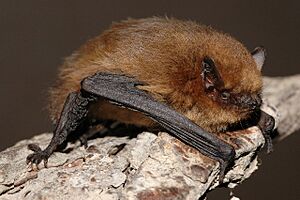Soprano pipistrelle facts for kids
Quick facts for kids Soprano pipistrelle |
|
|---|---|
 |
|
| Conservation status | |
| Scientific classification | |
| Genus: |
Pipistrellus
|
| Species: |
pygmaeus
|
 |
|
| Global range of P. pygmaeus (green) | |
The soprano pipistrelle (Pipistrellus pygmaeus) is a small type of bat. You can find these bats living across Europe. They often make their homes in buildings, like rooftops.
Contents
Understanding the Soprano Pipistrelle
For a long time, people thought the soprano pipistrelle was the same kind of bat as the common pipistrelle. But in 1999, scientists realized they were actually different species. These two bat types might have become separate species in the Mediterranean Sea area. This could be why the soprano pipistrelle can handle warm temperatures up to 40 degrees Celsius (104 degrees Fahrenheit).
Since then, scientists have found many other differences between them. These include how they look, where they live, and what they eat. The first big clue was their echolocation calls. Echolocation is how bats use sound to "see" in the dark. The common pipistrelle uses a call of 45 kHz (kilohertz). The soprano pipistrelle, however, calls at a higher pitch of 55 kHz. Because of this, the soprano pipistrelle is also known as the 55 kHz pipistrelle or the brown pipistrelle.
Where Soprano Pipistrelles Live
Soprano pipistrelles are found all over Europe. They often make their roosts, or resting places, in rooftops and houses. One study found that bats might prefer rooftops because they offer different temperatures. Even though these bats can handle heat up to 40 degrees Celsius, they prefer not to get much hotter. Rooftops give bat mothers and their babies access to cooler spots on hot days. They can also find warmer spots at other times.
Scientists learned this by using different colored bat boxes. They saw which boxes the bats used most often. Black bat boxes could get very warm, but bats used them a lot. This suggests they like warmer temperatures sometimes. Another study found that a soprano pipistrelle's home area is quite small, about 487 hectares (about 1,200 acres). This area often includes farmland, woodlands, and grasslands.
When it comes to finding food, soprano pipistrelles really love areas near rivers and streams. They choose these "riparian woodlands" much more than other places. Their hunting areas can be quite far from their roost, sometimes 4 to 10 kilometers (2.5 to 6 miles) away. Areas with water are also very important. Together, these two types of habitats make up most of their hunting time.
How Soprano Pipistrelles Live and Hunt
Soprano pipistrelles enjoy using different roosting spots. Some bats in a group might even use only these other spots. If these bats were kept out of their main roost, they would not go back. Instead, they would start a new group in one of their favorite alternative spots. Many of these alternative roosts were in buildings like bungalows and large houses.
Bats might use different roosts because of something called "torpor." Torpor is like a short-term hibernation. It helps bats save energy. They might also want to be around 40 degrees Celsius at certain times, especially when mothers are raising their young.
Soprano pipistrelles only use a small part of their home area to find food. This area is usually close to their day roost. Since they prefer to hunt near water, many bats might hunt in the same areas. When mothers are pregnant and nursing their babies, they fly longer distances to find food. However, they make fewer short flights than common pipistrelles. This might be because soprano pipistrelle groups are larger. They also might need less energy because of how they control their body temperature.
During the time when soprano pipistrelle mothers have their babies, there are often more wetlands nearby. This is probably not by chance. Most bats in a group use one main roost from April to October. This is likely because they need to be close to wetland habitats to find their special diet.
Reproduction and Life Cycle
Soprano pipistrelles gather in large groups called maternity colonies when they are pregnant and nursing their young. These colonies can become very big. They are much larger than common pipistrelle colonies, which usually have fewer than 200 bats. The large size of these groups can sometimes cause a strong smell for humans living nearby.
When a female soprano pipistrelle is early in her pregnancy, she leaves her roost later in the evening. As her pregnancy continues and when she is nursing, she leaves earlier. Early pregnancy happens in May. Late pregnancy is in June and July, and nursing happens in August.
Echolocation Sounds
Soprano pipistrelles use echolocation to find their way and hunt insects in the dark. The sounds they make for echolocation are between 53 and 86 kHz. The strongest part of their call is at 55 kHz. Each sound they make lasts for about 5.8 milliseconds (a very short time!).
Images for kids




